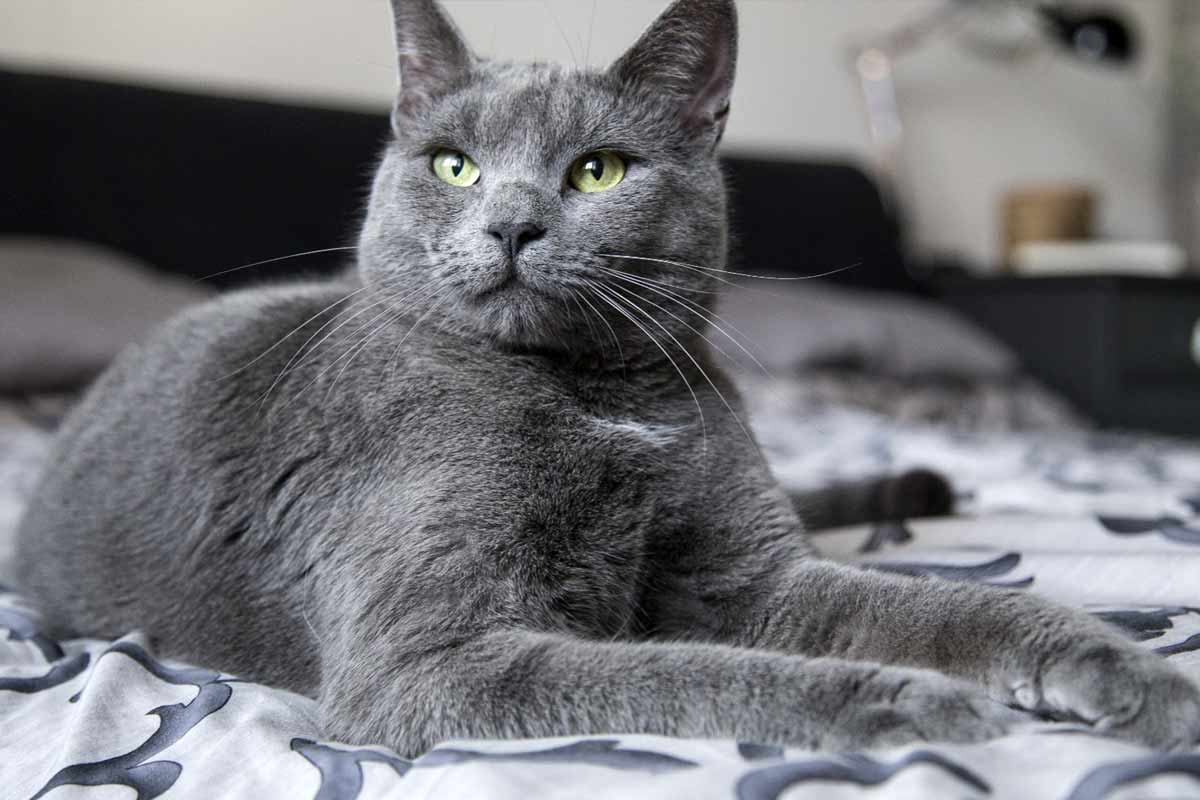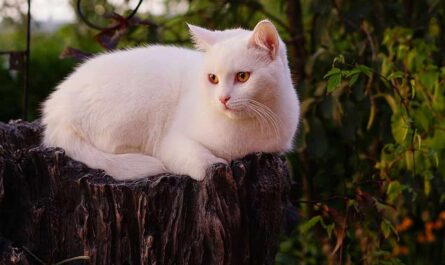The Russian Blue, a cat breed with an enchanting personality and temperament, brings a unique charm to any household. Renowned for their intellect, these felines revel in the warm embrace of their family. They’re more than willing to engage in playful games like fetching, eagerly becoming your playmate. Remarkably, they don’t mind having a bit of alone time, and their innate ability to amuse themselves adds an element of independence to their character.
The Russian Blue’s Historical Odyssey:
Delving into the rich tapestry of the Russian Blue’s history reveals intriguing theories. One popular belief traces their roots to the Archangel Isles in Northern Russia, where they thrived before embarking on a voyage with sailors to Europe in the 1800s. Another theory links them to the feline companions of Russian Czars, attributing their heritage to these regal connections.
It is widely believed that the Russian Blue’s roots can be traced back to Arkhangelsk, a northern Russian town known as the “archangel town.”
In the mid-1800s, they embarked on a maritime journey to England, accompanying sailors and leaving their indelible mark on feline history. Following the upheaval of World War II, the breed faced a pivotal moment, with efforts to preserve it involving crossbreeding with Siamese, British Shorthair, and European Shorthair cats. Through these threads of history, the Russian Blue’s legacy endures, a testament to their resilience and allure. Cat accessories on Amazon
Vital Statistics:
Weight: 5.5-14 lbs (2.5-6.5 kg)
Origin: Russia
Color: Blue
Fur: Short, thick, with an undercoat
Lifespan: 12-18 years
Personality: Quiet, a little shy, docile, independent
A Tapestry of Breed Characteristics:
The Russian Blue cat, like a whispered secret from the Russian wilderness, embodies a unique tapestry of characteristics. With its ethereal gray-blue to silver fur, slender physique, and graceful movements, it exudes an air of gentility and refinement that’s unmistakable.
Unraveling Their Personality and Temperament:
Beneath their quiet exterior, Russian Blues harbor a playful spirit and keen intelligence. They revel in the art of climbing and jumping, granting them a lofty vantage point from which to observe their world. Remarkably clever, they possess a penchant for problem-solving and are known to open doors and cupboards with ease – a sign of their inquisitive minds.
A Devotion Beyond Words:
Once you step through your front door, prepare to be shadowed by the inquisitive Russian Blue. Their penchant for human companionship knows no bounds, often leading them to follow you from room to room, curious about your every move. However, while they bask in the comfort of family, a touch of shyness might envelop them when strangers enter their world.
Creatures of Routine:
These feline wonders adore a predictable routine and thrive on it. From their perspective, mealtimes should always be served like clockwork, and they revel in the familiar cadence of a family’s daily life.
Ideal Family Companions:
Russian Blues gracefully accommodate the presence of children, making them ideal for families. Though they embrace youngsters with open paws, they might secretly harbor a favorite family member, with whom they form an especially strong bond.
Navigating Health Waters: Common Russian Blue Diseases & Conditions:
The Russian Blue’s devotion to food can sometimes lead to weight-related issues. They have an innate love for indulgence, making it vital to monitor their diet closely to ward off weight-related ailments.
Eyesight in Shadows: Progressive Retinal Atrophy:
The feline world knows of a condition called progressive retinal atrophy, a family of eye disorders that gradually erode the retina. Initially, it dims night vision, and as it progresses, it robs cats of their daylight sight. Remarkably, many cats adapt well to this vision loss if their surroundings remain unaltered.
The Struggle of Kidney Cysts: Polycystic Kidney Disease:
Polycystic Kidney Disease (PKD) stands as an inherited condition, often making its presence known from a tender age. This ailment triggers the formation of fluid-filled cysts in the kidneys, interfering with their proper function. In severe cases, it can lead to chronic renal failure if left undetected. Watch for signs like poor appetite, frequent vomiting, excessive thirst, frequent urination, lethargy, and depression. Diagnosis typically involves ultrasounds, and treatment options may range from dietary adjustments to medication and hormone therapy.
Navigating the Urinary Tract: Feline Lower Urinary Tract Disease (FLUTD):
Russian Blues, like many other felines, might encounter Feline Lower Urinary Tract Disease (FLUTD), a condition affecting the bladder and urethra. Cats grappling with FLUTD display signs of pain and difficulty when urinating. Additionally, they may exhibit increased urination frequency, visible blood in their urine, excessive genital licking, and occasional random urination around the house. It’s essential to maintain a dialogue with a veterinarian regarding these symptoms, as they might resurface throughout a cat’s life.
A Quest for Stability:
Russian Blues thrive in environments marked by routine and orderliness. Sudden changes in surroundings, mealtimes, or an unkempt litter box can send their world into disarray. To keep them content, consistency is key. The hustle and bustle of a chaotic household is not their cup of tea.
A Heart Full of Devotion:
While initially reserved around strangers, Russian Blues form deep bonds with their human companions. Their affectionate nature craves attention, and they favor sensitive, composed individuals. These cats are not built for solitude; leaving them alone for extended periods can lead to unhappiness.
A Symphony of Pros and Cons:
Pros:
- An excellent choice for first-time cat owners.
Docile and calm in temperament.
Friendly and sociable, even with other pets.
Demonstrates independence and intelligence.
Masters tricks such as playing fetch or opening doors.
Cons:
Tends to be reserved with strangers.
Prone to gaining weight easily.
Distinguishing Russian Blue from Chartreux:
Russian Blues are often mistaken for Chartreux cats due to their similar fur color. However, the key to telling them apart lies in their eyes. Russian Blues boast striking emerald green eyes, while Chartreux cats enchant with their amber-orange gaze.
A Unique Coat of Many Layers:
The Russian Blue cat lays claim to a rare double-layered coat, comprising both an undercoat and a topcoat. Both layers share the same length, giving the fur a distinctive stand-on-end quality and an irresistibly soft texture.
An Allure of Gray-Blue and Emerald Green:
The defining features of a Russian Blue include a monochromatic gray-blue coat, coupled with captivating, oversized emerald green eyes. Interestingly, newborn kittens sport blue eyes, which gradually transform into their signature green hue within two years.
From Archangel Cat to Russian Blue: A Rebirth After War:
Originally known as the Archangel Cat, the Russian Blue made its debut in England in 1875. However, the tumultuous era of World War II threatened to erase this breed from existence, with their numbers dwindling precariously. After the war, both Russia and Scandinavia embarked on a mission to revive and develop the breed. While these captivating felines made their way to the United States in the early 1900s, it wasn’t until after World War II that their popularity soared. The 1960s saw British breeders come together, working tirelessly to restore the breed’s distinctive features and boost the population of Russian Blue cats.
Recognized by Esteemed Associations:
The Russian Blue’s regal presence is officially recognized by prestigious feline associations, including the Cat Fanciers Association (CFA), the American Cat Fancier’s Association (AFCA), and the International Cat Association (TICA).
A Treasury of Russian Blue Facts:
Unveiling the world of Russian Blue Cats leads us to discover a treasure trove of trivia. Did you know that these felines were originally referred to as Archangel Cats? They possess a unique blend of dog-like behaviors, willingly indulging in the occasional game of fetch. Instead of darting away when the doorbell rings, they’ve been known to inspect visitors before making their graceful exit. These cats, unlike their talkative counterparts, are generally not very vocal. In a charming historical footnote, the Russian Blue made its public debut at the Crystal Palace in London in 1875.
FAQs
Russian Blue cats are a distinct and sought-after breed known for their striking blue-gray coat and captivating green eyes. Their breed originated in Russia, hence the name, and they are believed to have been brought to Europe by British sailors in the 1860s. These cats are known for their elegant appearance, gentle disposition, and unique characteristics.
Why are Russian Blue cats so special?
Russian Blue cats are special due to their stunning appearance, characterized by a short, dense, bluish-gray coat that has a unique silvery sheen. Their striking, vivid green eyes and the slightly arched back add to their elegance. They are also known for their gentle and reserved nature, making them excellent companions for those seeking a calm and loyal feline friend.

How many kg is a Russian Blue cat?
A Russian Blue cat’s weight can vary, but on average, adult males typically weigh between 4.5 to 6.8 kilograms (10 to 15 pounds), while adult females usually weigh between 2.7 to 4.5 kilograms (6 to 10 pounds). These are general weight ranges for the breed, and individual cats may fall within or outside of these ranges.
Do Russian Blue cats grow?
Yes, Russian Blue cats do grow. Like all cats, they go through a growth phase as kittens and continue to develop as they reach adulthood. The rate of growth varies among individuals, but Russian Blue cats usually reach their full size and maturity by around 1 to 1.5 years of age.
Do Russian Blue cats like the sun?
Russian Blue cats are known for their preference for cooler environments and are often sensitive to excessive heat. While they may enjoy sunbathing occasionally, they generally prefer shaded or cooler areas. It’s essential to provide them with a comfortable and well-ventilated living space, especially in hot weather, to ensure their well-being.
Are Russian Blue cats talkative?
Russian Blue cats are not known for being excessively talkative. They tend to be more reserved and quiet compared to some other breeds known for their vocal nature, like Siamese cats. However, individual personalities can vary, and some Russian Blues may be more talkative than others.
What is a full-size Russian Blue cat?
A full-size Russian Blue cat typically refers to an adult cat that has reached its full growth and maturity. As mentioned earlier, adult males generally weigh between 4.5 to 6.8 kilograms (10 to 15 pounds), and adult females usually weigh between 2.7 to 4.5 kilograms (6 to 10 pounds). They have their full-size frame by around 1 to 1.5 years of age.
Do Russian Blue cats jump a lot?
Russian Blue cats are agile and active but not particularly known for excessive jumping compared to some other breeds. They may jump onto surfaces like countertops or windowsills to explore their environment, but they don’t typically engage in high-energy jumping behaviors like some breeds bred for agility and athleticism.
How do you tell if a cat is a true Russian Blue?
To determine if a cat is a true Russian Blue, look for the breed’s distinctive characteristics. These include a short, dense, bluish-gray coat with a silvery sheen, vivid green almond-shaped eyes, a slightly arched back, and a medium-sized, elegant body. Additionally, check for the breed’s gentle and reserved temperament, which is often characteristic of Russian Blues.
What is the smartest color cat?
There’s no conclusive evidence to suggest that a cat’s coat color determines its intelligence. A cat’s intelligence is influenced by various factors, including genetics, early socialization, and environmental enrichment. Intelligence can manifest in different ways, such as problem-solving abilities, adaptability, and social interactions. It’s important to remember that intelligence can vary widely among individual cats, regardless of their coat color.
Can a Russian Blue have a black cat?
Russian Blue cats typically have a distinct bluish-gray coat with a silvery sheen. While they may have variations in their coat color, it would be unusual for a purebred Russian Blue to have a completely black coat. If a Russian Blue cat has black patches or markings, it may indicate a mixed breed or genetic variation.
Can Russian Blue Cats open doors?
Russian Blue cats, like many other cat breeds, can learn to open doors with lever-style handles or knobs if they are clever and persistent. Cats are naturally curious and may try to manipulate objects in their environment. To prevent this, consider installing childproof locks or door stoppers to keep them from accessing areas you want to keep off-limits.
Why does my Russian Blue cat lick me?
Cats may lick their owners for various reasons. Licking can be a sign of affection and a way for cats to bond with their humans. It’s also a grooming behavior, and they may lick you to clean you as if you were part of their family. Additionally, licking can be a form of communication, expressing comfort or seeking attention. It’s generally a positive behavior that indicates your cat feels close to you.
Are Russian Blue cats good with kids?
Russian Blue cats are known for their gentle and reserved temperament, which can make them good companions for families with children. However, like any cat breed, individual personalities can vary. It’s important to introduce the cat to children gradually and teach kids how to interact respectfully with the cat. Supervision is essential to ensure both the cat and children are comfortable and safe.
Are male or female Russian Blues better?
The choice between a male or female Russian Blue cat often depends on individual preferences and the cat’s personality rather than gender. Both males and females can make wonderful pets. Neutering or spaying can also help mitigate some gender-specific behaviors. When adopting a Russian Blue, focus on the cat’s temperament and compatibility with your lifestyle rather than their gender.
What are the three types of Russian Blue?
There is typically one recognized type of Russian Blue cat, which is characterized by its bluish-gray coat, silvery sheen, vivid green almond-shaped eyes, slightly arched back, and medium-sized, elegant body. Russian Blue cats are known for their gentle and reserved temperament, which is a defining characteristic of the breed. While there may be variations in coat shades among individual cats, they are generally consistent with the breed’s standards.
Are Russian Blue cats stubborn?
Russian Blue cats are not particularly known for being stubborn. They are more renowned for their reserved and gentle nature. However, like all cats, individual personalities can vary, and some Russian Blues may exhibit independent or stubborn behaviors from time to time. Positive reinforcement training methods can help encourage desired behaviors in any cat, including Russian Blues.
Do Russian Blue cats like the cold?
Russian Blue cats tend to tolerate cooler temperatures better than extreme heat. They have a dense, insulating coat that helps them stay comfortable in colder weather. While they may enjoy sunning themselves in moderately cold weather, it’s essential to provide them with warm shelter during chilly winters to ensure their well-being.
Which color cat is most intelligent?
There’s no scientific evidence to suggest that a cat’s color is directly linked to its intelligence. Cat intelligence can vary greatly among individual cats, regardless of their coat color. A cat’s intelligence is influenced by factors like genetics, socialization, and environmental stimulation rather than their coat color. Intelligence can manifest in various ways, such as problem-solving abilities, adaptability, and social interactions, and it varies from cat to cat.
Is Russian Blue a good cat breed?
Yes, Russian Blue cats are considered a good cat breed for various reasons. They are known for their gentle and friendly demeanor, which makes them great companions. They are typically quiet and well-behaved, and their short coat requires minimal grooming. Their intelligence and curiosity also make them engaging pets.
Is Russian Blue Cat expensive?
The cost of a Russian Blue cat can vary depending on factors like their pedigree, age, and breeder reputation. On average, a Russian Blue kitten from a reputable breeder can cost anywhere from $400 to $2,000 or more. Adoption from a shelter may be a more affordable option.
Who is the most expensive cat?
The title of the most expensive cat can vary over time and depends on various factors. Certain breeds, such as the Savannah cat, Ashera cat, and Bengal cat, have been known to command high prices. However, it’s essential to consider that a cat’s value goes beyond its price tag, and factors like health, temperament, and suitability as a pet should also be considered.
What color cat is the most expensive?
The most expensive cat colors often depend on the breed and individual cat’s qualities. For example, in some breeds like the Bengal or Siamese, certain coat patterns and colors may be considered more desirable and, therefore, can command higher prices. However, the expense of a cat is not solely determined by its color but by a combination of factors, including breed rarity and demand.
How long do Russian Blue cats live?
Russian Blue cats have a relatively long lifespan compared to some other cat breeds. On average, they can live for 15 to 20 years or even longer with proper care. Maintaining their health, providing a balanced diet, regular vet check-ups, and a loving environment contribute to their longevity.
What do Russian Blue cats eat?
Russian Blue cats, like all cats, require a balanced diet for optimal health. High-quality commercial cat food, whether dry or wet, is a suitable choice. Some owners also opt for a combination of commercial food and homemade meals, but it’s crucial to ensure that their nutritional needs are met. Always provide fresh water and consult with a veterinarian for specific dietary recommendations.
Are Russian Blue cats intelligent?
Yes, Russian Blue cats are considered intelligent. They are known for their problem-solving abilities and curiosity. They enjoy interactive toys and mental stimulation. Their intelligence makes them trainable, and they can learn tricks or behaviors with patience and positive reinforcement.
Do Russian Blue cats sleep?
Like all cats, Russian Blue cats do sleep, and they can sleep quite a bit. On average, cats sleep around 12-16 hours a day, with some variation among individuals. Russian Blues may be active during the evening and night, as they are known for their nocturnal tendencies.
Do Russian Blue cats get sick?
Like all pets, Russian Blue cats can get sick or develop health issues. Regular veterinary check-ups, vaccinations, and preventive care are essential to keep them healthy. Some breed-specific health concerns in Russian Blues include heart conditions and dental issues, but these can be managed with proper care. Cat accessories on Amazon
Can Russian Blue cats have milk?
Contrary to popular belief, many adult cats, including Russian Blues, are lactose intolerant, meaning they can’t digest lactose, a sugar found in milk, properly. Feeding them milk can lead to digestive upset, including diarrhea. It’s best to provide fresh water for hydration and avoid offering milk.
How big are Russian Blue cats in kg?
Russian Blue cats are typically medium-sized cats. Their weight can vary, but adult males usually weigh between 4.5 to 6.8 kilograms (10 to 15 pounds), while adult females typically weigh between 2.7 to 4.5 kilograms (6 to 10 pounds). These are general guidelines, and individual cats may fall outside of these ranges. Proper nutrition and exercise can help maintain a healthy weight for your Russian Blue.
More Interesting Articles
- 13 Very Interesting Facts About an Orange Tabby Cat
- Maine Coon Cat Breed: Traits, Profile, Personality, Facts
- 13 Interesting Fun Facts about Siamese Cats & Kittens
- 7 Amazing Light Brown (Beige) Cream Cat Breeds
- 10 Amazing Blue Cat Breeds with Short or Long Hair
- 11 Interesting Facts about a Cream Cute Tabby Cat
- 13 Common Symptoms of A Dead Kitten Inside A Cat
- Neutering Male Cats: Behavior and Recovery Guide
- How to Help a Choking Cat: Signs, Precautions, Tips
- Cat Dry Heaving: Cat Gagging Causes and What to Do
- Why is My Cat Panting? Symptoms, and Treatment
- 26 Tips How to Train A Cat Not to Scratch You or Anything
- Everything You Need to Know about Owning A Cat: 23 Facts
- How to Easily Train Your Cat to Use Toilet in One Week
- 10 Steps How to Train A Kitten to Use A Litter Box in a Week
- 10 Tips How to Train A Cat to Walk On a Leash in A Week
- 6 Steps How to Train A Cat Not to Bite Your Hand or Skin
- 6 Steps How to Get My Cat to Stop Jumping on the Counter
- 8 Tips on Introducing A New Dog To A Cat Step By Step
- 27 Tips How to Train An Outdoor Cat to Stay Home



